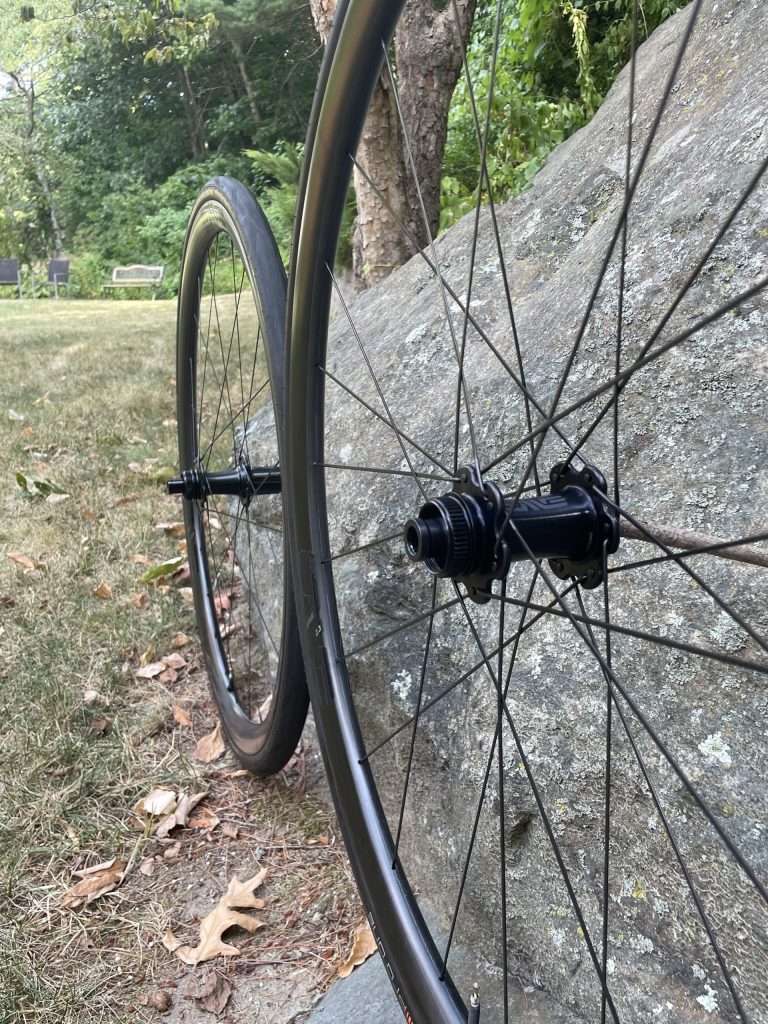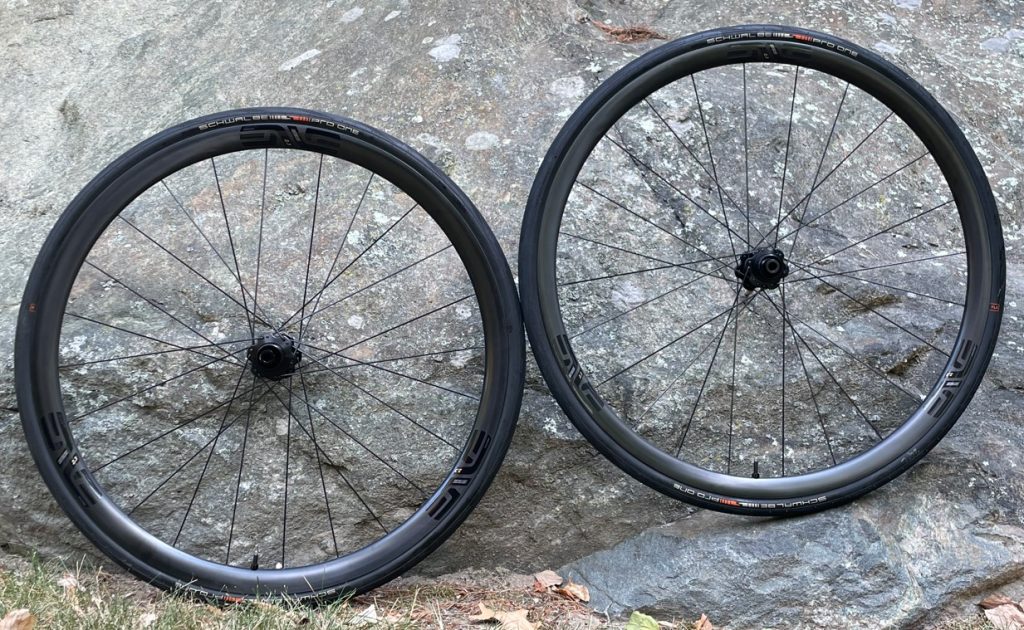ENVE SES 2.3 – A PURE CLIMBER

The ENVE SES 2.3 is the epitome of a pure climbing wheelset. If I were writing a story about the ten best road climbs in the world for some glossy magazine, I’d ask the publisher to feature a photo of a cyclist on a bike with ENVE SES 2.3 wheels to give my article the utmost authenticity.
Many of us enthusiasts put our game faces on when it’s time to head up a 7% or steeper pitch, be it on a mountain road or a segment of a rolling course. We’ll shift down into an easier gear, slow our cadence, and grind it out.
Going down is usually a well-earned thrill. But, depending on your confidence in your bike and handling skills, the excitement can be full of nervous or freeing energy.
The ENVE SES 2.3 makes me want to seek out a well-paved climb and revel in the descent. While not the wheelset I would choose for every day, flatter rides or those on rougher surfaces, if it’s a day with 1,000 feet or so of elevation every 10 miles, I want to roll on the 2.3s.
Fellow-tester and P/1/2 road and crit racer Miles reported that the ENVE SES 2.3 “flew uphill.” Nate, a hill climb event podium regular, noted how well the wheelset transferred his power and felt “very light” for climbing. For me, a true uphill grinder, these ENVEs help me remember, if not relive, my younger days when I could get uphill as fast as my riding buddies.
It’s one of the stiffest and lightest climbing wheelsets we’ve tested. That’s an unbeatable combination. But, as we’ve noticed in its deeper wheels like the SES 3.4 and SES 4.5, there’s something in the way ENVE designs or laces or tensions its wheels that give them a spring-like response that sets them apart when it’s go-time.
Nate enthused the ENVE 2.3 is very lively and responsive. Even in his stiff Specialized Venge bike, “the wheels accelerate fast and give back the power you put in. And the hub engages immediately and is also nice and quiet.”
Miles bragged that he was winning town line sprints against riders with deeper wheels. He also used the wheels’ superior responsiveness and acceleration in pacelines to maneuver away from trouble when riders in front of him quickly changed their line without maintaining their speed.
Miles and Nate quickly noted how confidently and predictably the ENVE SES 2.3 went downhill. Miles leaned into them without hesitation at high speeds on technical descents during one P/1/2 race. With zero need to micro-adjust for side-to-side motion, Nate was totally comfortable riding downhill at higher speeds.
I’ll admit to being a bit more cautious than my better bike-handling fellow testers when cornering at downhill speeds on these ENVE wheels. While all of us rode the 2.3 with 28mm Schwalbe Pro One TLE tires, and I also tested them with the same size Continental Grand Prix 5000 S TR, I didn’t feel as confident leaning into turns as I do on climbing wheels that have a 25mm internal and 30mm external rim width compared to the 2.3’s 21.1 mm internal, 25.7mm external measured dimensions.
Call me spoiled or a wimp, but I prefer wider rims for my tires.
Nate and I also experienced less compliance on rougher roads on the ENVE SES 2.3 than on other climbing wheels we’ve tested. We inflated the tires close to the pressure ENVE recommends for these wheels, the tire width, and our weight, pressures consistent with the SRAM tire pressure calculator and a good deal less than the Silca one.
Still, you can feel every imperfection on an asphalt road and get a harsh ride on older or naturally rough pavement like chip seal.
And, of course, with its 28.5mm deep front wheel and 32.6mm deep rear, these aren’t aero stars. You can certainly accelerate up to aero speeds quickly, but keeping it there is more work than we’ve experienced on most other climbing wheels.
That’s less important in a paceline where drafting plays a bigger part. But, as a wheelset that’s less aero and less comfortable than most, the ENVE SES 2.3 isn’t one we’d choose for its versatility to ride both on climbing days and for everyday training and racing on various terrain.
But, for the fast-riding road enthusiast and racer looking for a dedicated climbing wheelset, the ENVE SES 2.3 is off the front. With a retail price of US$2850, £3350, €4000, you can order it using these links to recommended stores Competitive Cyclist, BTD (BikeTiresDirect), Merlin, and Sigma Sports.
Compare our reviews and ratings of the ENVE SES 2.3 with competitively performing models in my review of the Best Lightweight Wheels For Climbing.
In The Know Cycling is ad-free, subscription-free, and reader-supported. If you want to help keep it rolling without any added cost to you, buy your gear and kit after clicking the store links on the site. When you do, we may earn an affiliate commission that will help me cover the expenses to create and publish our independent, comprehensive and comparative reviews. Thank you, Steve. Learn more.


Great review, thanks!
I bought an S-Works Aethos frame set some weeks back and built it up with components (Sram force, Favero powermeter axles, etc.) I had over.
Really loving this bike although it is not extremely light with my parts.
I run the Nextie NXT34ARX with Michelin PowerCup TLR 28mm now. Really love the combination.
I could now upgrade to ENVE SES 2.3 with Vittoria Corsa Pro (run them on my C68 and love them), which would be about 220g lighter than the Nextie.
Do you think this (quite) expensive move would make sense? Will I feel the difference in the weight of the wheels?
Thanks,
Alex
Alex, Hadn’t heard of your Nextie wheels so I looked them up. The front and rear rims (390g) are each over 100g more than the ENVE (front-275g, rear-280g). So yes, I think you would feel the difference in the weight alone. I’d also guess they would be a stiffer wheelset since ENVE wheels are indeed stiffer than most. That would translate to the sense of lighter wheels as they’d be more responsive. They might not be as comfortable as the Nexties are a good deal wider, but if actual weight and the feeling of lighter weight are important to you, then yes, the ENVE 2.3 are hard to beat. Steve
Thanks Steve! And do you think the aerodynamics of the 2.3 would be much worse than the Nextie’s?
Alex, Neither of them are going to give you any aero benefit. They’re too shallow. Work on your body position 🙂 Steve
Hi Steve,
thanks again!
I think I will try the 2.3.
Have the 6.7 on my C69, the 3.4 on my Mosaic GT2 and the 4.5 on my Open MIN.D. So only the 2.3 are missing.
Also read your review on the 6.7: I think they are almost as versatile as the 4.5 as the weight difference is so little and they handle wind great. 🙂
The only time an aero wheel really matters is on a solo breakaway or an ITT. Most races are done while drafting in a pack and aero wheels make little to no difference in those situations. So it really depends on being honest with yourself and truly asking yourself how often if ever you find yourself in those two situations. No wheel on the planet is going to permit you to hold the wheel of a better rider that wants to drop you and vice versa. The distances over which those separations occur are typically so short that anyone who thinks some deep Princeton or Lightweight nosebleed priced Fred wheel is going to magically have you hold the wheel of a better rider that chooses to make a move to drop you is kidding themselves and living in LaLa marketing mark fantasyland. Yes, over a long solo distance they will cut some time off, but over short distances where actual race moves occur such wheels means next to nothing regarding holding a position or dropping someone off your own wheel, or outsprinting someone to a finish.
Mike, I agree with all of that but what about all the time when you’re not racing or if you don’t race. Solo rides, training rides, pulling at the front of a group, and doing a breakaway in a race all benefit from being more aero than not, including aero wheels. There are also a lot of accelerations in crits where being aero comes in handy. And the better 50-60mm wheels now are nearly as aero as deeper TT ones, far more aero than climbing wheels and are light enough to climb with on all but those days when it’s steep enough for long enough to justify a dedicated climbing wheelset like the ENVE SES 2.3 Steve
I’ve got a pair of 2.3s for my Aethos as well. They are amazing on steep climbs for me! But they definitely hit a wall at about 20mph in terms of aerodynamics. I’ve added a set of 3.4s for regular riding and they feel much faster everywhere else and I like the wider tire profile with 28s in terms of comfort and cornering on rougher roads.
Thanks for the review. Been looking for someone to review these wheels for a while. How would these compare to a pair of lightweight weigweiser evo in your opinion as a climbing focus wheel? The Enve 2.3 have a wider rim (18.5 vs 22) and coupled with a DT Swiss 180 hub, I can cut 300g approx..
Tariq, I don’t see the lightweight weigweiser evo in their current line up of wheels. I think the Obermayer EVO is the current lightest and shallowest wheelset they make that’s also disc brake and tubeless ready. The ENVE 2.3 with the HG freehub and claimed Obermayer weight are essentially the same. The weight of the rims matters a lot more than the hubs. I haven’t ridden this Obermayer but having ridden a Meilenstein (that’s also narrower than the ENVE 2.3), I didn’t notice it was any stiffer than the ENVE, at least not at the watts I put out, and not nearly as comfortable as the ENVE which wasn’t very comfortable in the first place. And then there’s the price of the Lightweight…Steve